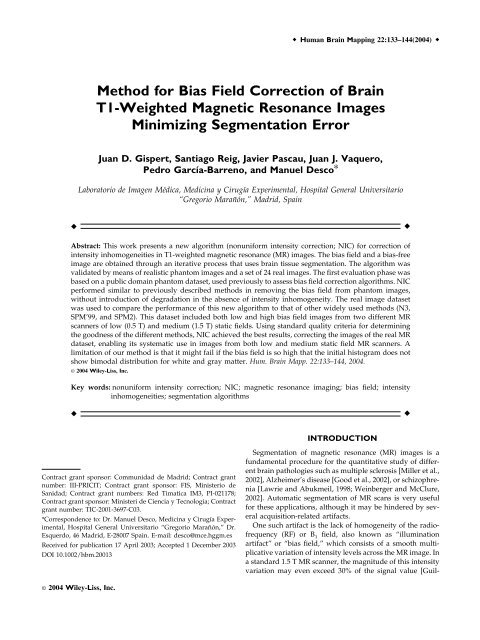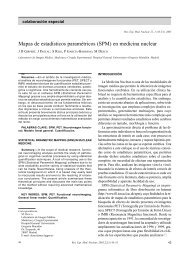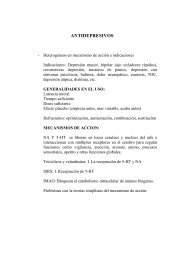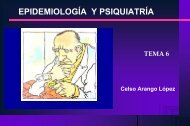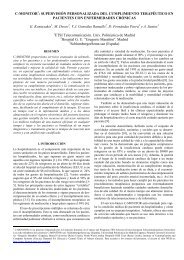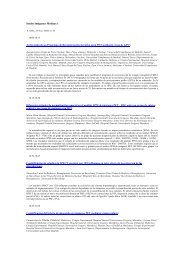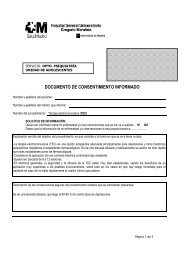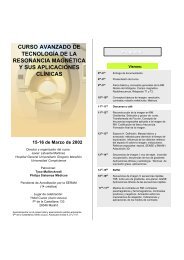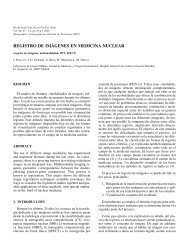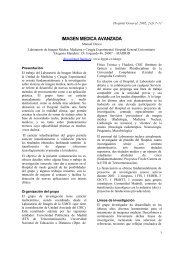Method for Bias Field Correction of Brain T1-Weighted Magnetic ...
Method for Bias Field Correction of Brain T1-Weighted Magnetic ...
Method for Bias Field Correction of Brain T1-Weighted Magnetic ...
Create successful ePaper yourself
Turn your PDF publications into a flip-book with our unique Google optimized e-Paper software.
Human <strong>Brain</strong> Mapping 22:133–144(2004) <br />
<strong>Method</strong> <strong>for</strong> <strong>Bias</strong> <strong>Field</strong> <strong>Correction</strong> <strong>of</strong> <strong>Brain</strong><br />
<strong>T1</strong>-<strong>Weighted</strong> <strong>Magnetic</strong> Resonance Images<br />
Minimizing Segmentation Error<br />
Juan D. Gispert, Santiago Reig, Javier Pascau, Juan J. Vaquero,<br />
Pedro García-Barreno, and Manuel Desco*<br />
Laboratorio de Imagen Médica, Medicina y Cirugía Experimental, Hospital General Universitario<br />
“Gregorio Marañón,” Madrid, Spain<br />
<br />
<br />
Abstract: This work presents a new algorithm (nonuni<strong>for</strong>m intensity correction; NIC) <strong>for</strong> correction <strong>of</strong><br />
intensity inhomogeneities in <strong>T1</strong>-weighted magnetic resonance (MR) images. The bias field and a bias-free<br />
image are obtained through an iterative process that uses brain tissue segmentation. The algorithm was<br />
validated by means <strong>of</strong> realistic phantom images and a set <strong>of</strong> 24 real images. The first evaluation phase was<br />
based on a public domain phantom dataset, used previously to assess bias field correction algorithms. NIC<br />
per<strong>for</strong>med similar to previously described methods in removing the bias field from phantom images,<br />
without introduction <strong>of</strong> degradation in the absence <strong>of</strong> intensity inhomogeneity. The real image dataset<br />
was used to compare the per<strong>for</strong>mance <strong>of</strong> this new algorithm to that <strong>of</strong> other widely used methods (N3,<br />
SPM’99, and SPM2). This dataset included both low and high bias field images from two different MR<br />
scanners <strong>of</strong> low (0.5 T) and medium (1.5 T) static fields. Using standard quality criteria <strong>for</strong> determining<br />
the goodness <strong>of</strong> the different methods, NIC achieved the best results, correcting the images <strong>of</strong> the real MR<br />
dataset, enabling its systematic use in images from both low and medium static field MR scanners. A<br />
limitation <strong>of</strong> our method is that it might fail if the bias field is so high that the initial histogram does not<br />
show bimodal distribution <strong>for</strong> white and gray matter. Hum. <strong>Brain</strong> Mapp. 22:133–144, 2004.<br />
© 2004 Wiley-Liss, Inc.<br />
Key words: nonuni<strong>for</strong>m intensity correction; NIC; magnetic resonance imaging; bias field; intensity<br />
inhomogeneities; segmentation algorithms<br />
<br />
<br />
INTRODUCTION<br />
Contract grant sponsor: Communidad de Madrid; Contract grant<br />
number: III-PRICIT; Contract grant sponsor: FIS, Ministerio de<br />
Sanidad; Contract grant numbers: Red Timatica IM3, PI-021178;<br />
Contract grant sponsor: Ministeri de Ciencia y Tecnologia; Contract<br />
grant number: TIC-2001-3697-C03.<br />
*Correspondence to: Dr. Manuel Desco, Medicina y Cirugía Experimental,<br />
Hospital General Universitario “Gregorio Marañón,” Dr.<br />
Esquerdo, 46 Madrid, E-28007 Spain. E-mail: desco@mce.hggm.es<br />
Received <strong>for</strong> publication 17 April 2003; Accepted 1 December 2003<br />
DOI 10.1002/hbm.20013<br />
Segmentation <strong>of</strong> magnetic resonance (MR) images is a<br />
fundamental procedure <strong>for</strong> the quantitative study <strong>of</strong> different<br />
brain pathologies such as multiple sclerosis [Miller et al.,<br />
2002], Alzheimer’s disease [Good et al., 2002], or schizophrenia<br />
[Lawrie and Abukmeil, 1998; Weinberger and McClure,<br />
2002]. Automatic segmentation <strong>of</strong> MR scans is very useful<br />
<strong>for</strong> these applications, although it may be hindered by several<br />
acquisition-related artifacts.<br />
One such artifact is the lack <strong>of</strong> homogeneity <strong>of</strong> the radi<strong>of</strong>requency<br />
(RF) or B 1 field, also known as “illumination<br />
artifact” or “bias field,” which consists <strong>of</strong> a smooth multiplicative<br />
variation <strong>of</strong> intensity levels across the MR image. In<br />
a standard 1.5 T MR scanner, the magnitude <strong>of</strong> this intensity<br />
variation may even exceed 30% <strong>of</strong> the signal value [Guil-<br />
© 2004 Wiley-Liss, Inc.
Gispert et al. <br />
lemaud and Brady, 1997]. Although this artifact may be<br />
unnoticeable to the eye, it can clearly degrade the volumetric<br />
quantification <strong>of</strong> cerebral tissues, particularly when using<br />
automatic segmentation algorithms based on intensity levels.<br />
For this reason, bias field correction algorithms are used<br />
mainly to reduce classification error rates (CER) when segmenting<br />
images into different tissue types.<br />
This artifact may have several causes, such as lack <strong>of</strong><br />
uni<strong>for</strong>m sensitivity <strong>of</strong> the RF emitting and receiving coils,<br />
static field (B 0 ) inhomogeneities, gradient-induced eddy currents,<br />
magnetic susceptibility <strong>of</strong> tissue, interslice cross-talk,<br />
RF standing wave effects, and attenuation <strong>of</strong> the RF signal<br />
inside the object [Simmons et al., 1994; Sled and Pike, 1998].<br />
Magnitude <strong>of</strong> the bias field is stronger in high static field<br />
machines because <strong>of</strong> the higher RF frequencies used. A<br />
corrective calibration, as is usually carried out with magnetic<br />
field inhomogeneity [Cusack et al., 2003], is not feasible<br />
because the attenuation depends on every individual sample<br />
and precludes any static correction. Some methods developed<br />
<strong>for</strong> the measurement <strong>of</strong> the RF inhomogeneity in vivo<br />
are not practical <strong>for</strong> the clinical routine, as they require<br />
specific equipment and are time consuming [Sled and Pike,<br />
1998]. <strong>Correction</strong> <strong>of</strong> the bias field there<strong>for</strong>e is addressed<br />
usually by post-acquisition mathematical algorithms.<br />
The different correction strategies proposed can be classified<br />
roughly into two types, depending on whether they use<br />
segmentation or not. Many examples can be found <strong>of</strong> different<br />
algorithms <strong>for</strong> correcting intensity inhomogeneities that<br />
do not use any segmentation. Homomorphic filtering methods<br />
[Brinkmann et al., 1998; Johnston et al., 1996] assumed<br />
no overlapping between the low-frequency bias field and<br />
the high-frequency image in<strong>for</strong>mation. Dawant et al. [1993]<br />
proposed a method to correct image intensities based on a<br />
previous selection (either manual or automatic) <strong>of</strong> reference<br />
points in white matter. The method in DeCarli et al. [1996]<br />
was based on differences between local and global medians.<br />
Vokurka et al. [1999] combined two methods to correct intraand<br />
interslice intensity nonuni<strong>for</strong>mity, whose effect on surface<br />
coil images was studied further [Vokurka et al., 2001].<br />
Cohen et al. [2000] applied a gaussian filtering scheme,<br />
minimizing filtering artifacts by assigning the mean signal<br />
intensity to the background voxels. The methods by Mangin<br />
[2000] and Likar et al. [2001] fitted the bias field with parametric<br />
basis functions whose coefficients were determined<br />
through entropy minimization. Another approach has been<br />
to take the intensity inhomogeneity artifact into account<br />
during the MR reconstruction process [Schomberg, 1999].<br />
All these methods do not make use <strong>of</strong> any tissue segmentation;<br />
however, the bias field correction can be improved<br />
noticeably by taking advantage <strong>of</strong> a tissue classification.<br />
Following this strategy, different methods have been developed<br />
that simultaneously carry out the tissue segmentation<br />
and the field correction. An iterative method based on the<br />
expectation-maximization (EM) algorithm was proposed by<br />
Wells et al. [1996] and improved by Guillemaud and Brady<br />
[1997]. All these methods involve the following steps: (1)<br />
classification <strong>of</strong> the image voxels into a set <strong>of</strong> predefined<br />
tissue classes; (2) calculation <strong>of</strong> a bias-free image by assigning<br />
voxels in each class its mean tissue intensity; (3) calculation<br />
<strong>of</strong> a residual image as the subtraction <strong>of</strong> the bias-free<br />
image from the original image; (4) estimation <strong>of</strong> the bias<br />
field by smoothing the residual image; and (5) correction <strong>of</strong><br />
the original image using this estimated bias field. The whole<br />
process is iterated until no improvement is observed in a<br />
certain quality parameter.<br />
The method in Ashburner and Friston [1997] introduced<br />
prior spatial in<strong>for</strong>mation into the classification step by making<br />
use <strong>of</strong> a probabilistic template. This method, detailed<br />
further by Ashburner and Friston [2000], was included in the<br />
SPM99 s<strong>of</strong>tware package, and a newer version <strong>of</strong> the algorithm<br />
(SPM2) has been released recently [Ashburner, 2002].<br />
Van Leemput et al. [1999a,b] modified the algorithm by<br />
adding a Markov model to steer the tissue classification.<br />
Several other methods have adopted similar strategies: The<br />
N3 algorithm [nonparametric nonuni<strong>for</strong>m intensity normalization;<br />
Sled et al., 1998] used an iterative algorithm to<br />
estimate both the multiplicative bias field (represented by a<br />
combination <strong>of</strong> smooth B-splines) and the distribution <strong>of</strong> the<br />
true tissue intensities in the MR volume. Shattuck et al.<br />
[2001] followed an analogous scheme, also fitting B-splines<br />
to local estimates <strong>of</strong> the bias field. Pham and Prince [1999]<br />
and Ahmed et al. [2002] estimated the bias field using an<br />
adaptive fuzzy C-means classification together with a multiscale<br />
pyramidal algorithm. Zhang et al. [2001] made use <strong>of</strong><br />
a hidden Markov model to simultaneously carry out the<br />
segmentation and the correction. Marroquin et al. [2002]<br />
modeled separately the intensity inhomogeneity <strong>of</strong> each tissue<br />
class using parametric models.<br />
The lack <strong>of</strong> an optimal solution is thus highlighted by<br />
many bias field correction strategies in the literature. Un<strong>for</strong>tunately,<br />
evaluation and testing <strong>of</strong> all these algorithms have<br />
not received the same attention. Velthuizen et al. [1998]<br />
carried out a review <strong>of</strong> MRI intensity nonuni<strong>for</strong>mity correction<br />
methods and an evaluation <strong>of</strong> their impact on measurements<br />
<strong>of</strong> brain tumor volumes. They reported that tumor<br />
segmentation was not improved by these methods, and the<br />
result was attributed to the fact that tumors are usually very<br />
localized. Another comprehensive article by Arnold et al.<br />
[2001] showed a quantitative comparison <strong>of</strong> the six most<br />
representative algorithms used currently to correct inhomogeneity<br />
artifacts. Their main conclusion was that none <strong>of</strong> the<br />
methods per<strong>for</strong>med ideally in all cases, particularly considering<br />
that some methods were not robust with images showing<br />
little or no bias field effect. Locally adaptive methods<br />
provided more accurate corrections than did non-adaptive<br />
techniques, suggesting that the <strong>for</strong>mer are more efficient<br />
when dealing with some features <strong>of</strong> brain anatomical variability,<br />
like the asymmetry between left and right hemispheres.<br />
Chard et al. [2002] investigated the reproducibility<br />
<strong>of</strong> the SPM99 segmentation method <strong>for</strong> the assessment <strong>of</strong><br />
brain volume measurements and concluded that the bias<br />
field correction markedly improved the repeatability <strong>of</strong> tissue<br />
segmentation.<br />
134
<strong>Bias</strong> <strong>Field</strong> <strong>Correction</strong> <strong>of</strong> <strong>T1</strong>-<strong>Weighted</strong> MR Images <br />
Despite its unquestionable interest, the use <strong>of</strong> real image<br />
datasets to measure the efficiency and robustness <strong>of</strong> the<br />
inhomogeneity correction raises the problem <strong>of</strong> establishing<br />
appropriate goodness criteria. The use <strong>of</strong> phantom images<br />
simplifies evaluation <strong>of</strong> correction algorithms, because a bias<br />
field <strong>of</strong> known magnitude can be added easily. When measuring<br />
the efficiency <strong>of</strong> correction algorithms with real image<br />
datasets, the actual bias field in the images is not known.<br />
Our work presents a new, locally adaptive algorithm <strong>for</strong><br />
correction <strong>of</strong> the bias field artifact in <strong>T1</strong>-weighted MR scans<br />
based on minimization <strong>of</strong> the CER between different cerebral<br />
tissues. The algorithm has been validated with an available<br />
realistic phantom, used previously in the study by<br />
Arnold et al. [2001]. Our results were compared to those<br />
reported in that work. In addition, the usefulness <strong>of</strong> our<br />
algorithm <strong>for</strong> segmentation has been evaluated on real images<br />
obtained by scanning a set <strong>of</strong> subjects in two MR<br />
machines <strong>of</strong> low (0.5 T) and medium (1.5 T) field. The<br />
algorithm was compared to three <strong>of</strong> the most widely used<br />
correction methods (N3 [Sled et al., 1998], SPM99 [Ashburner<br />
and Friston, 2000], and SPM2 [Ashburner, 2002]),<br />
using commonly accepted criteria.<br />
MATERIAL AND METHODS<br />
The rationale <strong>of</strong> our algorithm (NIC; nonuni<strong>for</strong>m intensity<br />
correction) is to make use <strong>of</strong> the estimated error rate <strong>of</strong> a<br />
tissue segmentation as a goodness parameter <strong>for</strong> correction<br />
<strong>of</strong> the bias field. The algorithm estimates a CER by modeling<br />
tissue intensities with a mixture <strong>of</strong> basis functions and measuring<br />
their overlap.<br />
Description <strong>of</strong> the NIC Algorithm<br />
The NIC algorithm iterates two major stages, “tissue classification”<br />
and “bias field estimation.” The tissue classification<br />
stage provides in<strong>for</strong>mation to create a bias-free image,<br />
used in the second stage to obtain both an estimation <strong>of</strong> the<br />
inhomogeneity field in the original image and a CER. Because<br />
the bias field is assumed to be smooth and multiplicative,<br />
it can be estimated as the quotient between smoothed<br />
versions <strong>of</strong> the original and bias-free images. The algorithm<br />
iterates until no improvement <strong>of</strong> the CER is achieved in<br />
three successive steps. Figure 1 shows a flowchart <strong>of</strong> the<br />
whole process.<br />
Tissue Classification<br />
For the algorithm to operate properly, no more than three<br />
tissues types must appear: gray matter, white matter, and<br />
cerebrospinal fluid (CSF). This makes it necessary to exclude<br />
all the extracranial voxels using a segmentation method. In<br />
our case, this segmentation, available previously, had been<br />
obtained by thresholding the original image and manually<br />
editing the extracranial mask obtained. This task is not critical,<br />
however, and could be accomplished using any <strong>of</strong> the<br />
many different automatic methods available [Atkins and<br />
Mackiewich, 1998; Brummer et al., 1993; Shattuck et al., 2001;<br />
Stokking et al., 2000]. The histogram <strong>of</strong> the masked image is<br />
modeled with five basis functions: three gaussians corresponding<br />
to pure cerebral tissues (white and gray matter<br />
and CSF) and two additional probability densities <strong>for</strong> partial<br />
volume voxels, assumed to contain only two pure tissues<br />
(gray–white matter and CSF–gray matter). Different statistical<br />
models <strong>for</strong> partial volume voxels are thoroughly described<br />
in Santago and Gage [1995]. Following the notation<br />
<strong>of</strong> Ruan et al. [2000], the partial volume density functions are<br />
defined by<br />
where<br />
p(y m ,a) <br />
Figure 1.<br />
Flowchart <strong>of</strong> the NIC algorithm.<br />
1<br />
p(y m ) <br />
1<br />
2a 2 1 2 (1 a) 2 2<br />
2 <br />
0<br />
p(y m ,a) da (1)<br />
exp [y m (a 1 1 a) 2 )] 2<br />
2[a 2 1 2 (1 a) 2 2 2 ]<br />
(2)<br />
135
Gispert et al. <br />
Figure 2.<br />
a: Example <strong>of</strong> a theoretical density distribution<br />
<strong>for</strong> the partial volume voxels according to the<br />
model implemented in the NIC algorithm.<br />
Probability density functions <strong>of</strong> two tissue<br />
types and <strong>of</strong> their partial volume voxels are<br />
shown (Tissue 1 mean 200 50; Tissue 2<br />
mean 800 100). b: Example <strong>of</strong> real MR<br />
histogram fitted by five basis functions. Pure<br />
tissue and partial volume voxel basis functions<br />
are highlighted. The segmentation error can<br />
be estimated as the overlap between the basis<br />
functions.<br />
being p(y m ,a)the probability <strong>of</strong> a voxel with proportions <strong>of</strong><br />
pure tissues a and (1 a) to present an intensity level y m .<br />
Mean and standard deviation <strong>of</strong> the intensity levels <strong>of</strong> the<br />
pure tissues are represented by ( 1 , 2 ) and ( 1 , 2 ) respectively<br />
(Fig. 2a). This model assumes that all a values occur<br />
with the same probability, because partial volume voxels<br />
may consist <strong>of</strong> any fraction <strong>of</strong> pure tissue classes. Parameters<br />
<strong>of</strong> the basis functions are estimated iteratively with an EM<br />
(expectation-maximization) algorithm [Dempster et al.,<br />
1977]. At each EM iteration, a Bayesian approach is used to<br />
calculate the classification thresholds that yield the minimum<br />
error rate. This error rate is estimated as the overlap<br />
between pure tissue distributions (Fig. 2b). The EM algorithm<br />
stops when the segmentation thresholds do not<br />
change in 10 consecutive iterations. The result <strong>of</strong> this stage is<br />
an estimation <strong>of</strong> the parameters <strong>of</strong> basis functions that<br />
model the image histogram.<br />
<strong>Bias</strong> <strong>Field</strong> Estimation<br />
In this stage, the parameters <strong>of</strong> the basis functions<br />
provided by the tissue classification are used to create a<br />
bias-free image. Those intracranial voxels with an intensity<br />
level within the 95% confidence intervals (95% CI) <strong>of</strong><br />
any <strong>of</strong> the two partial volume basis functions are classified<br />
as partial volume. The remaining intracranial voxels<br />
are considered pure tissue and classified into gray matter,<br />
white matter, and CSF using the minimum error-rate<br />
classification thresholds obtained in the tissue classification<br />
stage. The value <strong>of</strong> these pure tissue voxels is<br />
changed to the mean intensity <strong>of</strong> their corresponding<br />
tissue class (Fig. 3b), thus producing a bias-free image.<br />
Following the strategy proposed by Cohen et al. [2000] to<br />
reduce filtering artifacts, the values <strong>of</strong> all extracranial and<br />
partial volume voxels are set to the mean intracranial<br />
136
<strong>Bias</strong> <strong>Field</strong> <strong>Correction</strong> <strong>of</strong> <strong>T1</strong>-<strong>Weighted</strong> MR Images <br />
intensity both in the bias-free image and in the original<br />
one. Both images are then filtered with the same gaussian<br />
kernel. When the CER is no longer improved using a<br />
particular kernel size, its full width at half maximum<br />
(FWHM) is reduced to a half. With our images, the kernel<br />
size varied from 200 mm in the first iteration to 50 mm in<br />
the last one.<br />
At this point, the bias field is estimated as the quotient<br />
between the smoothed versions <strong>of</strong> the original and bias-free<br />
images (Fig. 3c). This procedure, however, does not provide<br />
a good estimation <strong>of</strong> the magnitude <strong>of</strong> the bias field, but the<br />
estimation can be optimized further to minimize the classification<br />
error. To this end, the original image is corrected<br />
with bias fields <strong>of</strong> different magnitudes, from 0–40% in<br />
steps <strong>of</strong> 1%, selecting the value that yields the lowest classification<br />
error.<br />
A bias-corrected MR image is calculated as the quotient<br />
between the original image and the estimated bias field. This<br />
corrected MR image is then entered as the original image in<br />
the tissue classification step, iterating the whole procedure<br />
until no improvement in the classification error is obtained<br />
in three consecutive steps. The parameter minimized by the<br />
NIC algorithm is actually the CER, despite the use <strong>of</strong> a<br />
maximum-likelihood EM algorithm in the tissue classification<br />
stage.<br />
Validation<br />
With the aim <strong>of</strong> thoroughly testing the per<strong>for</strong>mance <strong>of</strong> the<br />
NIC algorithm, both phantom and real image datasets were<br />
used. The main advantage <strong>of</strong> using realistic phantom images is<br />
that it enables assessment <strong>of</strong> the accuracy <strong>of</strong> the algorithm. The<br />
procedure works by adding a known multiplicative bias field<br />
and measuring the difference between the applied and extracted<br />
bias fields. These phantom images, on the other hand,<br />
may not be representative <strong>of</strong> real clinical cases. To assess the<br />
per<strong>for</strong>mance <strong>of</strong> the algorithm with real cases, we followed a<br />
different strategy. Because in this case the actual bias field was<br />
unknown, the evaluation was carried out by comparing parameters<br />
that estimate the residual amount <strong>of</strong> variability <strong>of</strong><br />
every tissue in the image after correcting the bias field.<br />
Phantom Dataset<br />
To facilitate comparison <strong>of</strong> our results to previous ones,<br />
we evaluated the NIC algorithm following the methodology<br />
proposed by Arnold et al. [2001], who studied six inhomogeneity<br />
correction methods 1 : N3 [Sled et al., 1998]; HUM<br />
[Brinkmann et al., 1998]; EQ [Cohen et al., 2000]; BFC [Shattuck<br />
et al., 2001]; SPM [Ashburner and Friston, 2000]; and<br />
CMA. 2 A paraboloidal and a sinusoidal bias field <strong>of</strong> maximum<br />
magnitude 8% bias fields were added to a realistic<br />
1 N3, nonparametric, nonuni<strong>for</strong>m intensity normalization; HUM,<br />
homomorphic unsharp masking; EQ, equalize; BFC, bias field corrector;<br />
SPM, statistical parametric mapping.<br />
2 Developed and provided by the Center <strong>for</strong> Morphometric Analysis<br />
at the Massachusetts General Hospital.<br />
MR brain phantom [Collins et al., 1998] with 3% gaussian<br />
noise. These phantom images are freely available in the<br />
Internet. 3 The quality <strong>of</strong> the correction was assessed by a<br />
scatterplot <strong>of</strong> applied versus extracted bias fields and its<br />
correlation coefficient (r). Ideally, the applied and extracted<br />
bias should have exactly the same shape and magnitude,<br />
with the scatterplot showing a perfectly straight slope <strong>of</strong> b<br />
1 with a correlation coefficient <strong>of</strong> r 1. The algorithm was<br />
also applied to the original phantom image without bias<br />
field to verify that no degradation was introduced in this<br />
case.<br />
Real Image Dataset<br />
Our real image dataset consisted <strong>of</strong> 24 brain MR images <strong>of</strong><br />
four healthy volunteers. Images were acquired in two clinical<br />
scanners (Gyroscan; Philips, The Netherlands) using a<br />
head coil, with 12 images at 0.5 T and 12 at 1.5 T. Each<br />
subject was scanned three times in every MR system. MR<br />
images were acquired using a <strong>T1</strong>-weighted 3D gradient echo<br />
sequence (flip angle 30 degrees, repetition time 15.4<br />
msec, echo time 4.6 msec), with a matrix size <strong>of</strong> 256 256<br />
110, and voxel size <strong>of</strong> 0.98 0.98 1.10 mm. The MRI<br />
acquisition protocol was intended to produce bias fields <strong>of</strong><br />
different strength and shape. Images at the higher B 0 field<br />
(1.5 T, 64 MHz) were expected to present a stronger bias<br />
field than were those obtained at a lower field (0.5 T, 22<br />
MHz), because the intensity inhomogeneity depended on RF<br />
signal attenuation inside the object under study [Sled and<br />
Pike, 1998]. To modify the shape <strong>of</strong> the bias field, the scanner<br />
bed was moved 1.5 cm in the second and third repetitions,<br />
presuming that a change in the relative positions <strong>of</strong> the<br />
emitting and receiving coils should produce a different map<br />
<strong>of</strong> sensitivity, thus varying the shape <strong>of</strong> the bias field [Deichmann<br />
et al., 2002].<br />
We used four parameters to assess the quality <strong>of</strong> intensity<br />
inhomogeneity correction: the coefficients <strong>of</strong> variation <strong>of</strong><br />
gray and white matter; the coefficient <strong>of</strong> joint variation <strong>of</strong><br />
gray and white matter; and the CER (the parameter minimized<br />
by our algorithm). The coefficient <strong>of</strong> variation <strong>of</strong> the<br />
white matter (CV WM ) and gray matter (CV GM ) have been<br />
employed widely as goodness parameters [Chard et al.,<br />
2002; Dawant et al., 1993; Likar et al., 2001; Sled et al., 1998].<br />
Coefficients <strong>of</strong> variation constitute a scale-independent measurement<br />
<strong>of</strong> the voxel intensity variability <strong>for</strong> any particular<br />
tissue type. Their interpretation may be difficult, however,<br />
when one tissue shows improvement and other shows degradation.<br />
Another parameter, the coefficient <strong>of</strong> joint variation<br />
<strong>of</strong> white and gray matter (CJV WG ), was proposed to<br />
overcome this problem [Likar et al., 2001]. It is defined by<br />
WM GM<br />
CJV WG <br />
WM GM<br />
3 Available online at http://pet.med.va.gov:8080/distrib/nu_compare.html<br />
(3)<br />
137
Gispert et al. <br />
Figure 3.<br />
Processing steps <strong>of</strong> the NIC bias correction<br />
algorithm. a: Original image. b: Segmented<br />
image (extracerebral and partial<br />
volume voxels have been excluded). c:<br />
Estimated bias field obtained as the quotient<br />
between smoothed versions <strong>of</strong> the<br />
original (a) and segmented images (b).<br />
and represents the sum <strong>of</strong> the standard deviations <strong>of</strong> the<br />
voxel intensities in WM and GM, normalized by the difference<br />
<strong>of</strong> their means. The coefficient <strong>of</strong> joint variation remains<br />
an approximate measurement <strong>of</strong> the classification<br />
error, as it does not take into account the relative amounts<br />
<strong>of</strong> the two tissues. Figure 4 shows an example <strong>of</strong> how two<br />
artificial tissue types with the same coefficient <strong>of</strong> joint<br />
variation may present a different classification error. For<br />
this reason, we estimated the quality <strong>of</strong> the classification<br />
by the CER. The calculation <strong>of</strong> all these quality parameters<br />
requires the identification <strong>of</strong> WM, GM, and CSF in the<br />
images. To this end, we used the classification method<br />
presented above.<br />
The four quality parameters were calculated in the original<br />
image dataset and after bias field correction by the NIC<br />
algorithm and by three other methods: N3 [Sled et al., 1998],<br />
SPM99 [Ashburner and Friston, 2000] and SPM2 [Ashburner,<br />
2002]. These algorithms were chosen based on their<br />
public availability 4 and wide use by the neuroscience community.<br />
The SPM99 s<strong>of</strong>tware includes two bias correction<br />
techniques, one intended <strong>for</strong> high magnitude bias fields<br />
4 N3: Available online at http://www.bic.mni.mcgill.ca/s<strong>of</strong>tware/N3;<br />
SPM’99: http://www.fil.ion.ucl.ac.uk/spm; SPM2: http://www.fil.<br />
ion.ucl.ac.uk/spm/spm2b.html<br />
(SPM99-S) and the other <strong>for</strong> moderate bias fields (SPM99-L).<br />
Tunable parameters in all algorithms were left at their default<br />
values.<br />
As a preceding validation step, to make sure that the four<br />
goodness parameters used were appropriate markers <strong>of</strong> intensity<br />
inhomogeneity, these parameters were calculated on<br />
phantom images with three bias fields <strong>of</strong> known magnitude<br />
(0, 20, and 40%). The phantom images used <strong>for</strong> this purpose<br />
were three <strong>Brain</strong>Web Normal <strong>Brain</strong> Database 5 <strong>T1</strong>-weighted<br />
images with 3% gaussian noise.<br />
RESULTS<br />
Results <strong>of</strong> the validation <strong>of</strong> the standard quality criteria<br />
(CV GM ,CV WM , and CJV WG ) showed that higher values <strong>of</strong><br />
these parameters corresponded to higher tissue dispersion<br />
caused by stronger bias fields (Table I).<br />
The CER also increased with the amount <strong>of</strong> known bias<br />
field in the phantom images (Table I). Furthermore, the same<br />
pattern <strong>of</strong> correspondence between increased coefficients <strong>of</strong><br />
variation and CER was also observed when using the set <strong>of</strong><br />
5 Available online at http://www.bic.mni.mcgill.ca/brainweb/<br />
selection_normal.html<br />
138
<strong>Bias</strong> <strong>Field</strong> <strong>Correction</strong> <strong>of</strong> <strong>T1</strong>-<strong>Weighted</strong> MR Images <br />
Figure 4.<br />
Examples <strong>of</strong> probability density functions with the<br />
same mean, variance (thus presenting the same<br />
coefficient <strong>of</strong> variation CV), and coefficient <strong>of</strong> joint<br />
variation (CJV). CER, however, is higher when the<br />
relative amounts <strong>of</strong> the two tissues ( 1 and 2 ) are<br />
closer.<br />
real images (Table II). These results support the validity <strong>of</strong><br />
using the CER criterion as a measurement <strong>of</strong> the amount <strong>of</strong><br />
bias field in the images.<br />
Validation <strong>of</strong> NIC Using Phantom Images<br />
Scatterplots <strong>of</strong> the applied versus extracted bias field (Fig.<br />
5a,b) showed a slightly higher coefficient <strong>of</strong> correlation (r<br />
0.98) <strong>for</strong> the paraboloidal bias than <strong>for</strong> the sinusoidal one<br />
(r 0.96). In the case <strong>of</strong> no bias field, the NIC algorithm<br />
proved to be robust: correlation between the original and<br />
corrected intensity values showed perfect agreement (r<br />
1.000) (Fig. 5c).<br />
TABLE I. Quality criteria measured on the <strong>Brain</strong> Web<br />
phantom with 0, 20, and 40% bias field magnitude<br />
<strong>Brain</strong> Web CV WM (%) CV GM (%) CJV WG (%) CER (%)<br />
0% bias field 4.84 7.03 43.02 0.65<br />
20% bias field 5.89 8.97 48.91 1.32<br />
40% bias field 7.56 12.26 59.84 3.22<br />
All quality parameters represent the amount <strong>of</strong> bias field in the<br />
images. CV WM, coefficient <strong>of</strong> variation <strong>of</strong> white matter; CV GM ,coefficient<br />
<strong>of</strong> variation <strong>of</strong> the gray matter; CJV WG , coefficient <strong>of</strong> joint<br />
variation <strong>of</strong> white and gray matter; CER, classification error rate.<br />
139
Gispert et al. <br />
TABLE II. Mean and range <strong>of</strong> the four quality criteria<br />
<strong>Method</strong> CV WM (%) CV GM (%) CJV WG (%) CER (%)<br />
0.5T(n 12)<br />
Uncorrected 5.39 (4.81, 5.96) 15.12 (13.27, 17.36) 108.75 (100.50, 138.71) 10.29 (9.40, 13.81)<br />
SPM99-L 9.14 (5.03, 34.77) 14.59 (10.60, 20.40) 129.15 (116.17, 177.92) 11.14 (10.49, 16.15)<br />
SPM99-S 10.13 (4.71, 33.82) 13.54 (10.17, 17.48) 132.03 (110.65, 170.94) 10.83 (9.63, 17.37)<br />
SPM2 5.29 (4.63, 6.24) 19.19 (10.73, 25.72) 122.17 (102.62, 156.21) 10.53 (9.38, 15.34)<br />
N3 5.15 (4.55, 5.42) 14.29 (12.90, 16.71) 113.65 (105.27, 135.79) 10.51 (9.73, 14.36)<br />
NIC 5.02 (4.39, 5.29) 14.48 (12.73, 16.56) 105.81 (99.84, 126.69) 9.79 (8.86, 13.44)<br />
1.5T(n 12)<br />
Uncorrected 6.52 (5.79, 7.59) 16.75 (12.74, 20.74) 83.92 (76.37, 97.10) 9.08 (8.74, 12.79)<br />
SPM99-L 6.26 (4.70, 7.41) 17.34 (14.44, 21.49) 105.97 (86.30, 135.33) 12.90 (10.08, 18.87)<br />
SPM99-S 5.53 (4.57, 6.22) 16.31 (13.80, 19.89) 93.40 (78.19, 107.37) 10.61 (8.99, 14.64)<br />
SPM2 7.50 (5.39, 8.67) 15.97 (12.00, 20.52) 88.69 (76.80, 99.76) 9.77 (8.69, 12.37)<br />
N3 5.88 (5.36, 6.45) 16.47 (14.75, 19.82) 83.95 (77.03, 91.37) 8.84 (8.15, 11.39)<br />
NIC 5.84 (5.30, 6.57) 15.70 (12.32, 19.88) 80.77 (74.95, 88.85) 8.04 (7.18, 10.96)<br />
Coefficient <strong>of</strong> variation <strong>of</strong> white matter (CV WM ), coefficient <strong>of</strong> variation <strong>of</strong> the gray matter (CV GM ), coefficient <strong>of</strong> joint variation <strong>of</strong> white and<br />
gray matter (CJV WG ), and classification error rate (CER) in the uncorrected original and corrected real images when using the SPM99, SPM2,<br />
N3, and NIC methods. Lower values denote lower bias field in the images.<br />
Comparison to Other <strong>Method</strong>s Using Real Images<br />
Maximum values <strong>of</strong> estimated bias field in the 0.5 T and<br />
1.5 T images were 13.03 3.03% and 17.92 4.61%, respectively.<br />
The CER obtained after segmentation <strong>of</strong> these raw<br />
images without any bias correction showed a mean value <strong>of</strong><br />
10.29 1.68% and 9.08 1.33%, respectively, <strong>for</strong> the 0.5 T<br />
and 1.5 T image sets. Segmentation error was lower <strong>for</strong> the<br />
1.5 T images, probably because <strong>of</strong> their better signal-to-noise<br />
ratio as compared to the 0.5 T images.<br />
To assess improvement in segmentation due to reduction<br />
<strong>of</strong> bias field artifact, the four quality parameters were calculated<br />
in the original image and after correction with the N3,<br />
SPM’99, SPM2, and NIC algorithms.<br />
The NIC algorithm achieved the highest reduction in the<br />
CJV WG and in the CER (Table II). This lower segmentation<br />
error reflects a more efficient reduction <strong>of</strong> the bias field<br />
artifact by the NIC algorithm. Although the reduction <strong>of</strong> the<br />
segmentation error achieved by the NIC algorithm (Table II)<br />
might seem too small to be relevant, it represents an improvement<br />
<strong>of</strong> 4.86% and 11.45% <strong>for</strong> the 0.5 and 1.5 T images,<br />
respectively, with respect to the original segmentation errors<br />
<strong>of</strong> the uncorrected images.<br />
Figure 6 shows an example <strong>of</strong> MR scan corrected by the<br />
NIC algorithm. Figure 7 shows the evolution <strong>of</strong> the bias field<br />
estimation through several iterations, and the evolution <strong>of</strong><br />
the corresponding segmentation can be seen in Figure 8.<br />
DISCUSSION<br />
Per<strong>for</strong>mance <strong>of</strong> NIC on Phantom Images<br />
The validation with phantom images used the same methodology<br />
and datasets used in the reference work <strong>of</strong> Arnold<br />
et al. [2001], thus enabling a direct comparison with our<br />
results <strong>for</strong> the NIC algorithm. Arnold et al. [2001] showed<br />
that both N3 and BFC achieved the best per<strong>for</strong>mance when<br />
correcting the paraboloidal bias field (correlation coefficient<br />
between applied versus extracted fields, r 0.98). N3<br />
yielded the best results in the removal <strong>of</strong> the sinusoidal field<br />
(r 0.96), and the HUM method introduced lower degradation<br />
when correcting phantom images without bias field<br />
(r 0.999).<br />
Comparing the applied versus extracted bias fields (Fig.<br />
5), the NIC algorithm obtained the same correlation coefficient<br />
(r 0.98) as N3 and BFC did <strong>for</strong> the 8% parabolic bias<br />
field. The NIC algorithm also achieved the same quality as<br />
that <strong>of</strong> the N3 method in the correction <strong>of</strong> the 8% sinusoidal<br />
bias field (r 0.96). When correcting phantom images<br />
without bias field, the NIC method showed better results (r<br />
1.000) than did HUM (r 0.999) and N3 (r 0.997).<br />
Although it is debatable whether such small differences in<br />
the per<strong>for</strong>mance <strong>of</strong> the different methods on phantom images<br />
are relevant in practice, the per<strong>for</strong>mance <strong>of</strong> NIC has<br />
proven to be as good as that <strong>of</strong> the best available methods.<br />
Summarizing the phantom-based evaluation in a variety<br />
<strong>of</strong> bias field conditions, it can be stated that the NIC algorithm<br />
showed better per<strong>for</strong>mance in correcting the bias field<br />
than did the methods evaluated in Arnold et al. [2001] and<br />
was the only one that did not introduce degradation when<br />
no bias field was present.<br />
Per<strong>for</strong>mance <strong>of</strong> NIC on Real Images<br />
Regardless <strong>of</strong> the promising results obtained using phantom<br />
images, the potential usefulness <strong>of</strong> the NIC algorithm<br />
should be evaluated in the scope <strong>of</strong> practical applications <strong>of</strong><br />
tissue segmentation <strong>of</strong> real sets <strong>of</strong> images. Our experimental<br />
setup allowed us to test the algorithm in high and low bias<br />
field conditions. The comparison <strong>of</strong> the per<strong>for</strong>mance in reducing<br />
the segmentation error achieved by the five methods<br />
140
<strong>Bias</strong> <strong>Field</strong> <strong>Correction</strong> <strong>of</strong> <strong>T1</strong>-<strong>Weighted</strong> MR Images <br />
Figure 5.<br />
Scatterplots and correlation coefficients between the<br />
applied versus extracted bias on phantom images<br />
containing 8% paraboloidal bias field (a), 8% sinusoidal<br />
bias field (b), and no bias field (c).<br />
tested (SPM99-S, SPM99-L, SPM2, N3, and NIC) suggested<br />
that the NIC algorithm was the more efficient method, as it<br />
consistently showed better values <strong>for</strong> all four quality criteria<br />
(Table II). The SPM99-S and N3 methods, compared to the<br />
NIC algorithm, achieved a higher reduction <strong>of</strong> the CV GM in<br />
the 0.5 T images. The SPM99-S method also yielded a better<br />
result <strong>for</strong> the CV WM <strong>for</strong> 0.5 T images. CJV WG and CER<br />
values, however, showed worse results <strong>for</strong> those methods,<br />
reaching an overall per<strong>for</strong>mance below that <strong>of</strong> the NIC<br />
algorithm.<br />
Regarding the robustness <strong>of</strong> the different algorithms in<br />
low bias field conditions (at 0.5 T), NIC was the only method<br />
that did not degrade the original scans, still reducing the<br />
segmentation error with respect to the initial images (Table<br />
II). A possible reason <strong>for</strong> the worse results on 0.5 T images<br />
may be the lower contrast <strong>of</strong> these images. Our method,<br />
however, per<strong>for</strong>med better than the others did without any<br />
particular tuning <strong>for</strong> this type <strong>of</strong> images. This result enables<br />
a systematic use <strong>of</strong> NIC in images with either intense or mild<br />
bias field artifact.<br />
Regarding the consequences <strong>of</strong> the bias field correction on<br />
the quality <strong>of</strong> the segmentation, Chard et al. [2002] found<br />
significant improvement <strong>of</strong> the reproducibility <strong>of</strong> volume<br />
measurements <strong>of</strong> brain tissues after correcting intensity inhomogeneities<br />
with the SPM99 algorithm. An improvement<br />
in reproducibility <strong>of</strong> such measurements thus is expected<br />
also when using our method, given its superior per<strong>for</strong>mance<br />
with respect to SPM99.<br />
The smoothing carried out on the bias field estimate had a<br />
significant impact on the results <strong>of</strong> the correction method.<br />
Conventional filtering techniques are unsatisfactory <strong>for</strong> this<br />
application due to boundary effects that significantly degrade<br />
overall per<strong>for</strong>mance [Sled et al., 1998]. Most standard<br />
methods model the bias field with low spatial frequency<br />
functions, such as a discrete cosine set [Ashburner and Friston,<br />
2000; Ashburner, 2002], low order polynomials [Likar et<br />
al., 2001; Van Leemput et al., 1999a] or 3-D splines [Sled et<br />
al., 1998]. The NIC algorithm uses a gaussian kernel to<br />
smooth the “residual” image. The degree <strong>of</strong> smoothing is a<br />
tunable parameter in all these methods; the highest bias field<br />
141
Gispert et al. <br />
Figure 6.<br />
NIC algorithm applied to a real MR image. Left: Original image, where the intensity inhomogeneity<br />
is almost unnoticeable. Middle: Original image adjusting the window-level around the mean<br />
intensity <strong>of</strong> the white matter. Note the smooth intensity variations caused by the bias field. Right:<br />
Corrected image with the same window level.<br />
spatial frequency in both SPM99 and SPM2 algorithms corresponds,<br />
by default, to 1/8 <strong>of</strong> the image dimensions. For a<br />
standard field <strong>of</strong> view <strong>of</strong> 256 256 mm, the maximum<br />
frequency component corresponds to about 32 mm, as compared<br />
to the NIC algorithm, which uses a minimum FWHM<br />
<strong>of</strong> 50 mm.<br />
The overall degree <strong>of</strong> smoothing in the N3 algorithm is the<br />
result <strong>of</strong> the combination <strong>of</strong> several parameters, such as the<br />
distance between the B-spline basis functions and their<br />
smoothness, among others. It thus is difficult to determine<br />
the actual degree <strong>of</strong> smoothing. With NIC, however, the<br />
smoothness is directly expressed in spatial units.<br />
A possible caveat in our evaluation procedure is that the<br />
CER, used as the goodness criteria minimized by the NIC<br />
algorithm, has also been one <strong>of</strong> the quality parameters used<br />
<strong>for</strong> assessing bias field correction. CER values thus might be<br />
prone to show better results in images corrected by the NIC<br />
algorithm. Nevertheless, we have shown also that the NIC<br />
algorithm achieves similarly good results when using the<br />
other quality criteria in both phantom and real image data<br />
sets (Tables I and II).<br />
The NIC method requires the MR segmentation step to be<br />
able to identify white and gray matter, which may fail if the<br />
histogram has an unexpected shape, e.g., when correcting<br />
images from very high field scanners. In this case, as Mangin<br />
[2000] has shown <strong>for</strong> 3 T scanners, the image histogram may<br />
not show a bimodal distribution <strong>for</strong> white and gray matter.<br />
Although our work has applied the NIC algorithm only to<br />
<strong>T1</strong>-weighted MR scans, its segmentation scheme allows a<br />
straight<strong>for</strong>ward extension to multispectral images.<br />
In summary, the new method (NIC) <strong>for</strong> correction <strong>of</strong><br />
intensity inhomogeneities in MR images per<strong>for</strong>med similar<br />
to previously described methods in removing the bias field<br />
from phantom images while not introducing degradation<br />
142
<strong>Bias</strong> <strong>Field</strong> <strong>Correction</strong> <strong>of</strong> <strong>T1</strong>-<strong>Weighted</strong> MR Images <br />
Figure 7.<br />
Top: Evolution <strong>of</strong> the bias field along several iterations. Bottom: change in the estimated bias field<br />
per iteration. FWHM value corresponds to the smoothing gaussian kernel (see text).<br />
Figure 8.<br />
Evolution <strong>of</strong> the segmentation <strong>of</strong> the frontal lobe: initial image, first and fourth iterations and final<br />
result <strong>of</strong> the NIC algorithm.<br />
when no intensity inhomogeneity was present. The per<strong>for</strong>mance<br />
<strong>of</strong> the proposed algorithm in the correction <strong>of</strong> real<br />
MR images has also been compared to that <strong>of</strong> other three<br />
widely used methods (N3, SPM99, and SPM2). NIC<br />
achieved the best results <strong>for</strong> low (0.5 T) and high (1.5 T) bias<br />
field images, enabling its systematic use in images from both<br />
low and medium static field MR scanners. The NIC algorithm<br />
presented in this study seems a valuable alternative to<br />
methods currently available <strong>for</strong> bias field correction.<br />
REFERENCES<br />
Ahmed MN, Yamany SM, Mohamed N, Farag AA, Moriarty T<br />
(2002): modified fuzzy C-means algorithm <strong>for</strong> bias field estimation<br />
and segmentation <strong>of</strong> MRI data. IEEE Trans Med Imaging<br />
21:193–199.<br />
Arnold JB, Liow JS, Schaper KA, Stern JJ, Sled JG, Shattuck DW, Worth<br />
AJ, Cohen MS, Leahy RM, Mazziotta JC, Rottenberg DA (2001):<br />
Qualitative and quantitative evaluation <strong>of</strong> six algorithms <strong>for</strong> correcting<br />
intensity nonuni<strong>for</strong>mity effects. Neuroimage 13:931–943.<br />
143
Gispert et al. <br />
Ashburner J (2002): Another MRI bias correction approach. In: 8th<br />
International Conference on Functional Mapping <strong>of</strong> the Human<br />
<strong>Brain</strong>, 25–28 September, Sendai, Japan.<br />
Ashburner J, Friston K (1997): Multimodal image coregistration and<br />
partitioning: a unified framework. Neuroimage 6:209–217.<br />
Ashburner J, Friston KJ (2000): Voxel-based morphometry: the<br />
methods. Neuroimage 11:805–821.<br />
Atkins MS, Mackiewich BT (1998): Fully automatic segmentation <strong>of</strong><br />
the brain in MRI. IEEE Trans Med Imaging 17:98–107.<br />
Brinkmann BH, Manduca A, Robb RA (1998): Optimized homomorphic<br />
unsharp masking <strong>for</strong> MR grayscale inhomogeneity correction.<br />
IEEE Trans Med Imaging 17:161–171.<br />
Brummer ME, Mersereau RM, Eisner RL, Lewine RR (1993): Automatic<br />
detection <strong>of</strong> brain contours in MRI datasets. IEEE Trans<br />
Med Imaging 12:153–166.<br />
Chard DT, Parker GJ, Griffin CMB, Thompson AJ, Miller DH (2002):<br />
The reproducibility and sensitivity <strong>of</strong> brain tissue volume measurements<br />
derived from an SPM-based segmentation methodology.<br />
J Magn Reson Imaging 15:259–267.<br />
Cohen MS, DuBois RM, Zeineh MM (2000): Rapid and effective<br />
correction <strong>of</strong> RF inhomogeneity <strong>for</strong> high field magnetic resonance<br />
imaging. Hum <strong>Brain</strong> Mapp 10:204–211.<br />
Collins DL, Zijdenbos AP, Kollokian V, Sled JG, Kabani NJ, Holmes<br />
CJ, Evans AC (1998): Design and construction <strong>of</strong> a realistic<br />
digital brain phantom. IEEE Trans Med Imaging 17:463–468.<br />
Cusack R, Brett M, Osswald K (2003): An evaluation <strong>of</strong> the use <strong>of</strong><br />
magnetic field maps to undistort echo-planar images. Neuroimage<br />
18:127–142.<br />
Dawant BM, Zijdenbos AP, Margolin RA (1993): <strong>Correction</strong> <strong>of</strong> intensity<br />
variations in MR images <strong>for</strong> computer-aided tissue classification.<br />
IEEE Trans Med Imaging 12:770–781.<br />
DeCarli C, Murphy DGM, Teichberg D, Campbell G, Sobering GS<br />
(1996): Local histogram correction <strong>of</strong> MRI spatially dependent<br />
image pixel intensity nonuni<strong>for</strong>mity. J Magn Reson Imaging<br />
6:519–528.<br />
Deichmann R, Good CD, Turner R (2002): RF inhomogeneity compensation<br />
in structural brain imaging. Magn Reson Med 47:398–402.<br />
Dempster AP, Laird NM, Rubin DB (1977): Maximum likelihood from<br />
incomplete data via the EM algorithm. J R Stat Soc 39:1–38.<br />
Good CD, Scahill RI, Fox NC, Ashburner J, Friston KJ, Chan D,<br />
Crum WR, Rossor MN, Frackowiak RS (2002): Automatic differentiation<br />
<strong>of</strong> anatomical patterns in the human brain: validation<br />
with studies <strong>of</strong> degenerative dementias. Neuroimage 17:29–46.<br />
Guillemaud R, Brady M (1997): Estimating the bias field <strong>of</strong> MR<br />
images. IEEE Trans Med Imaging 16:238–251.<br />
Johnston B, Atkins MS, Mackiewich B, Anderson M (1996): Segmentation<br />
<strong>of</strong> multiple sclerosis lesions in intensity corrected multispectral<br />
MRI. IEEE Trans Med Imaging 15:154–169.<br />
Lawrie SM, Abukmeil SS (1998): <strong>Brain</strong> abnormality in schizophrenia.<br />
A systematic and quantitative review <strong>of</strong> volumetric magnetic<br />
resonance imaging studies. Br J Psychiatry 172:110–120.<br />
Likar B, Viergever MA, Pernus F (2001): Retrospective correction <strong>of</strong><br />
MR intensity inhomogeneity by in<strong>for</strong>mation minimization. IEEE<br />
Trans Med Imaging 20:1398–1410.<br />
Mangin JF (2000): Entropy minimization <strong>for</strong> automatic correction <strong>of</strong><br />
intensity nonuni<strong>for</strong>mity. In: IEEE workshop in mathematical<br />
methods in biomedical image analysis. Hilton Head Island. SC:<br />
IEEE Press. p 162–169.<br />
Marroquin JL, Vemuri BC, Botello S, Calderón F, Fernández-Bouzas<br />
A (2002): An accurate and efficient bayesian method <strong>for</strong> automatic<br />
segmentation <strong>of</strong> brain MRI. IEEE Trans Med Imaging<br />
21:934–945.<br />
Miller DH, Barkh<strong>of</strong> F, Frank JA, Parker GJ, Thompson AJ (2002):<br />
Measurement <strong>of</strong> atrophy in multiple sclerosis: pathological basis,<br />
methodological aspects and clinical relevance. <strong>Brain</strong> 125:<br />
1676–1695.<br />
Pham DL, Prince JL (1999): Adaptive fuzzy segmentation <strong>of</strong> magnetic<br />
resonance images. IEEE Trans Med Imaging 18:737–752.<br />
Ruan S, Jaggi C, Xue J, Fadili J, Bloyet D (2000): <strong>Brain</strong> tissue classification<br />
<strong>of</strong> magnetic resonance images using partial volume<br />
modeling. IEEE Trans Med Imaging 19:1179–1187.<br />
Santago P, Gage HD (1995): Statistical models <strong>of</strong> partial volume<br />
effect. IEEE Trans Image Process 4:1531–1540.<br />
Schomberg H (1999): Off-resonance correction <strong>of</strong> MR images. IEEE<br />
Trans Med Imaging 18:481–495.<br />
Shattuck DW, Sandor-Leahy SR, Schaper KA, Rottenberg DA,<br />
Leahy RM (2001): <strong>Magnetic</strong> resonance image tissue classification<br />
using a partial volume model. Neuroimage 13:856–876.<br />
Simmons A, T<strong>of</strong>ts PS, Barker GJ, Arridge SR (1994): Sources <strong>of</strong><br />
intensity nonuni<strong>for</strong>mity in spin echo images at 1.5 T. Magn<br />
Reson Med 32:121–128.<br />
Sled JG, Pike GB (1998): Standing-wave and RF penetration artifacts<br />
caused by elliptic geometry: an electrodynamic analysis <strong>of</strong> MRI.<br />
IEEE Trans Med Imaging 17:653–662.<br />
Sled JG, Zijdenbos AP, Evans AC (1998): A nonparametric method<br />
<strong>for</strong> automatic correction <strong>of</strong> intensity nonuni<strong>for</strong>mity in MRI data.<br />
IEEE Trans Med Imaging 17:87–97.<br />
Stokking R, Vincken KL, Viergever MA (2000): Automatic morphology-based<br />
brain segmentation (MBRASE) from MRI-<strong>T1</strong> data.<br />
Neuroimage 12:726–738.<br />
Van Leemput K, Maes F, Vandermeulen D, Suetens P (1999a):<br />
Automated model-based bias field correction <strong>of</strong> MR images <strong>of</strong><br />
the brain. IEEE Trans Med Imaging 18:885–896.<br />
Van Leemput K, Maes F, Vandermeulen D, Suetens P (1999b):<br />
Automated model-based tissue classification <strong>of</strong> MR images <strong>of</strong><br />
the brain. IEEE Trans Med Imaging 18:897–908.<br />
Velthuizen RP, Cantor AB, Lin H, Fletcher LM, Clarke LP (1998):<br />
Review and evaluation <strong>of</strong> MRI nonuni<strong>for</strong>mity correction <strong>for</strong><br />
brain tumor response measurements. Med Phys 25:1655–1666.<br />
Vokurka EA, Thacker NA, Jackson A (1999): A fast model independent<br />
method <strong>for</strong> automatic correction <strong>of</strong> intensity nonuni<strong>for</strong>mity<br />
in MRI data. J Magn Reson Imaging 10:550–562.<br />
Vokurka EA, Watson NA, Watson Y, Thacker NA, Jackson A (2001):<br />
Improved high resolution MR imaging <strong>for</strong> surface coils using<br />
automated intensity non-uni<strong>for</strong>mity correction: feasibility study<br />
in the orbit. J Magn Reson Imaging 14:540–546.<br />
Weinberger DR, McClure RK (2002): Neurotoxicity, neuroplasticity,<br />
and magnetic resonance imaging morphometry: what is<br />
happening in the schizophrenic brain? Arch Gen Psychiatry<br />
59:553–558.<br />
Wells WM, Grimson WEL, Kikinis R, Jolesz FA (1996): Adaptive<br />
segmentation <strong>of</strong> MRI data. IEEE Trans Med Imaging 15:429–<br />
442.<br />
Zhang Y, Brady M, Smith S (2001): Segmentation <strong>of</strong> brain MR<br />
images through a hidden Markov random field model and the<br />
expectation-maximization algorithm. IEEE Trans Med Imaging<br />
20:45–57.<br />
144


